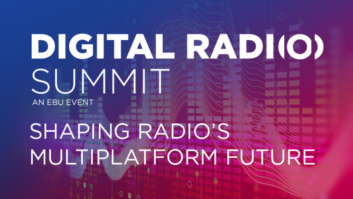FM and the Internet are the dominant distribution platforms for European public-service broadcasters, with AM radio being left in the dust.
This is one of the eye-opening conclusions contained in “Public Radio and New Media Platforms 2011” (PRNMP2011) research report issued by the European Broadcasting Union (EBU).

“Internet has become a vital platform for radio broadcasters to provide audio content, both live and on-demand,” according to the report’s executive summary. “It has [also] become increasingly common for public broadcasters to adapt their content to mobile access on devices such as mobile phones and smartphones/tablets.”
Very true: 100 percent of European public-service broadcasters surveyed stream audio online, 87 percent offer podcasts, and 68 percent have apps that let listeners tune in on smartphones or tablets.
Public-service broadcasters are also embracing social media, according to the report. Eighty-four percent of respondents are on Facebook, 61 percent tweet using Twitter, and 23 percent curate at least one blog.
This combined streaming/social strategy is paying off for these broadcasters, said EBU Head of Research Alex Shulzycki. “In an increasingly competitive radio market, European public broadcasters maintained a strong average 37 percent share for their national radio channels in 2010, unchanged from the previous year,” he said.
SHIFT FROM CONVENTIONAL
The Public Radio and New Media Platforms 2011 study does have some bad news, too: Conventional radio listening is on the decline, especially among younger audiences.
The biggest overall decline between 2006 and 2010 was in Sweden (down 13 percent across all audiences), with overall U.K. daily radio consumption dropping by 6 percent. Youth radio consumption during the same period dropped more than 15 percent in Sweden, Lithuania, Estonia and the United Kingdom.
“In general, radio listening via broadcast AM/FM networks is declining and the average listening time per listener is decreasing,” according to the report. “The decline in the number of radio listeners and the time spent listening is most marked among the younger generations.”
So who is stealing radio’s audiences? Research points to “new media” as the culprit: Online music and radio services, social media and other Internet sites and portable music players are drawing away young listeners.
Worth noting: Personalized music services such as Spotify and Last.fm (and in the U.S, Pandora) are gaining real traction among youth.
The penetration of Spotify in its native Sweden, the report stated, is now higher among younger generations than either public-service broadcaster Sveriges Radio or commercial radio stations. “Radio broadcasters need to grasp the online challenge and offer innovative features to counteract the popularity of these new services.”
SOCIAL MEDIA SUCCESS
How can radio get the most out of Facebook, Google+ or Twitter? The key is to use “social media like an umbilical cord, connecting listeners to producers when the radio is off,” according to the report.
The EBU researchers found that radio gets more results from social media when the broadcasters employ story-telling techniques to grab the attention of social media users.
There should also be unique content offered on each platform used so that consumers have reasons to check them all out. Cross-platform promotion — talking about social networks and websites on air and vice versa — is a must, and listener-generated content should be showcased online.
One last point: “Pay attention to on-topic posts published by listeners/fans/followers,” the report advises. Otherwise, these people will notice that you are not noticing them, and go elsewhere.
BOTTOM LINE
The EBU’s Public Radio and New Media Platforms 2011 report is worth reading, even if you just skim through the 21-page executive summary. Rather than just document the decline of conventional radio, the report also offers helpful ideas to help broadcasters (public and commercial) find their place in today’s multi-platform universe; including ways to reach the elusive youth audience via social media.
For broadcasters around the world — not just in Europe — commercial and public-service alike, this is timely and useful market intelligence. Take the time to check it out, for your radio station’s sake.











